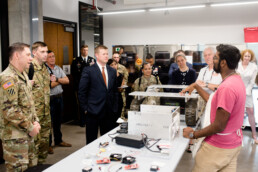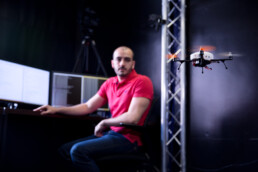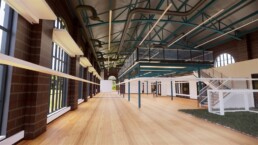In a major speech this past spring, the soldier in charge of modernizing technology for the U.S. Army and leading the Army Futures Command (AFC) issued a sweeping challenge to the nation’s engineers. Said Four Star General John Murray, “I never want to put a soldier in a breach again.”

His vision, he explained, is to keep flesh-and-blood soldiers out of harm’s way. When there’s a minefield to be traversed or barbed wire to be cut, it should be done by robots. Then he disclosed his primary partners in meeting this challenge: The University of Texas System and its flagship university, UT Austin.
UT Austin is building a new robotics center, as part of a multi-million-dollar partnership with the AFC, a newly launched command that represents the Army’s biggest reorganization since 1973. It could turn out to be just as big for some research areas in the Cockrell School of Engineering.
Under an initial contract, Texas Engineering faculty and students, along with researchers from UT’s College of Natural Sciences, will contribute futuristic research on robotics, as well as positioning, navigation and timing; network security; and hypersonics.
“It’s a real endorsement for the Cockrell School and for UT in general,” says Todd Humphreys, associate professor in the Department of Aerospace Engineering and Engineering Mechanics and one of UT’s collaborators with the AFC. “There are really compelling problems here — at the edge of what we can currently do. For students interested in pushing the frontiers of science and research, it’s inspiring, it will have consequences, and the U.S. desperately needs it.”
The school’s breakthroughs could also spin off whole new civilian industries, says John Ekerdt, associate dean for research in the Cockrell School.
“Because of the opportunities created by the Army Futures Command, other entities are circling around,” he says. “This could become a whole ecosystem. Because we’re at the center, we believe we will see long-term benefits for the school.”
Austin Means Innovation
The AFC’s mission is no less than to bring America’s military defense technology into the 21st century. Under existing procurement procedures, new systems can take decades to develop — like a replacement for the Bradley Fighting Vehicle, which has been in the works since 1999. In an age when adversaries are now testing hypersonic missiles, the Army doesn’t have decades.
“Four years ago, the Department of Defense realized we were losing our technical edge,” says Rex Eiserer, director of their University Technology Development Division. “It was time for a structural change.”
That change was a new command to focus on a single task: innovation. In place of a military chain-of-command, it would tap resources from other worlds, like the flexibility of high-tech startups and the experimental and applied research happening at the nation’s tier 1 research universities.
“In World War II, we did well because we had an industrial base to build off of,” Eiserer says. “Today, what’s also needed is an intellectual base. Fifty years ago, innovation was happening inside the government. Today, it’s happening outside the government — at corporations and universities.”
There’s no better place to find both, the AFC decided after a nationwide search, than Austin. Another attraction: nearby bases in Killeen and San Antonio, where discoveries could be field-tested quickly and efficiently. And, the Army already had a UT connection. The Army Research Lab South, headquartered at UT’s J.J. Pickle Research Campus in North Austin, oversees pioneering engineering and science at universities across the South.
For the AFC, UT Austin and the UT System strengthened the bond. In addition to $24 million from the Army, UT System and UT Austin combined to put up $50 million for investments to strengthen the faculty and to upgrade facilities where AFC-UT collaborations may thrive. UT System offered two floors of its headquarters downtown to build operations headquarters for the AFC, and in August 2018, the Army started moving in.
The university will also build a new facility at the Pickle Research Campus — in the same building as the Cockrell School’s Center for Electromechanics — for work needing tighter physical security. But the crown jewel will be on UT Austin’s main campus, where the historic Anna Hiss Gymnasium is being remodeled to house the new Robotics Center of Excellence.
Aye, Robots
When the AFC was looking to set up a robotics center, it was drawn to the fact that UT already had one — a very, very good one.
In 2015, Cockrell School faculty joined forces with Department of Computer Science faculty to launch Robotics at UT Austin, a consortium led by computer science professor Peter Stone that offers a Graduate Portfolio Program in Robotics from both schools. More than that, it’s a one-stop shop for robotics efforts across the whole campus. It includes seven labs and research groups, as well as faculty from UT’s School of Information and Dell Medical School.
“We recognize that robotics transcends and spans many departments,” says Mitch Pryor, research scientist in the Walker Department of Mechanical Engineering who will serve as director of the Robotics Center of Excellence. “We created this consortium so that we could collectively engage the industry as a group. It put us in a strong position to respond to the AFC.”
UT Austin had already committed additional faculty lines and begun the renovation of facilities to house the research in robotics. When completed next April, the renovated gymnasium will house the consortium, bringing together faculty from several departments along with the new Robotics Center of Excellence.
But the Army’s not waiting for new facilities. In May, it sent teams to the Cockrell School to present its needs in eight areas, ranging from networking and navigation to future vertical-lift vehicles. Professors responded with proposals, which were winnowed down to 19. Three-year grants will then be provided for select projects spread among the Cockrell School, the Department of Computer Science, the Robotics Center of Excellence and the Applied Research Laboratory at the Pickle Campus.
For most of the projects, the task is not to create finished products, but to do foundational research, which the Army can incorporate into its own designs — particularly into next-generation combat vehicles, including the successor to the Bradley.
“We’re not asking UT to build the Next-Generation Combat Vehicle,” Eiserer says. “But we need technologies we can get out the door quickly and into these next-generation systems.” Speed is of the essence, says Pryor. “They want to accelerate the pace of a technology’s maturity from government scale to a three-year commercial scale. These capabilities will be delivered to the army as software repositories or as demos of relevant hardware. The Army is less interested in reading a journal paper.”
This accelerated pace is just fine with Noel Clemens, professor and chair of the Department of Aerospace Engineering and Engineering Mechanics, who will be testing materials for hypersonic flight. “We told them we can start tomorrow, if we need to.”
A Future with the Futures Command
Those initial projects will be the first of many, Eiserer hopes. “We chose Austin for the long haul,” he says. Agrees Ekerdt, “I hope we’ll look at this 10 years down the road, and it will still be going.”
Over that time, the Army’s needs will change, and so will UT’s engineering research. Each year, the AFC will hold a symposium to present its latest priorities. From back-and-forth discussions with professors, specific projects will emerge.
“It’s not a single deliverable, but a pipeline,” says Pryor. “As they’re designing new systems, we can continuously be injecting new technologies into them. We have the ability at UT to pull from a range of faculty and specialists, to perform research in the areas where they have needs.”
People want to work on problems that make a difference. This is an opportunity to do that.”
—John Ekerdt, Cockrell School Associate Dean for Research
That pipeline will extend well beyond the military, school officials predict. Technologies first developed for the Pentagon have revolutionized the civilian world, from GPS to the internet. The Cockrell School’s research for the AFC could spark businesses — even industries — of tomorrow, for everything from robots to autonomous vehicles:
- Networks that help drones communicate could make passenger cars safer, says Constantine Caramanis, professor in the Department of Electrical and Computer Engineering. “If your car can talk to a car that’s around a corner, it can effectively see what’s around the corner.”
- A positioning system that’s more precise and resilient than GPS could be critical for package-delivering drones and even air taxis. “One has to have a reliable sense of its position, in three dimensions,” says Humphreys. “If somebody jams one signal, it has to be able to tap into different sources.”
For the present, though, both students and faculty will have the satisfaction of seeing immediate impacts from their work—far past the walls of their laboratories.
“People want to work on problems that make a difference,” Ekerdt says. “This is an opportunity to do that.”
A Peek at New UT‑AFC Research
Picture a commando team of a not-too-distant future. Its members are a robot, an autonomous armored vehicle and a swarm of drones. Though they’re cybersoldiers, they face the same challenges as their human counterparts, from setting courses to making group decisions. Here are some collaborative Cockrell School-A F C projects that might help meet those challenges — and non-military ones, as well:
Techno-Teaming

Global Positioning Systems turn up in every military vehicle, phone and radio. But they’ve gotten more and more vulnerable to jamming by hostile forces, says Humphreys.
His solution is a sensorium, a box bristling with several other kinds of location devices, from inertial sensors to radar and cameras. They might include receivers that could read signals from networks of satellites in low-earth orbits, like those planned by SpaceX and Amazon. The goal is to make it the size of a shoebox, so that it could be bolted on to a jeep or a tank.
“It’s much like the box you see on Google’s self-driving vehicles,” Humphreys says, “except that ours is operable in complete whiteout conditions.”
Beyond GPS

On a polar icepack, a robotic rover gathers scientific data while a self-flying drone tracks it from above. That’s a prototype that Maruthi Akella, professor in the Department of Aerospace Engineering and Engineering Mechanics, developed for NASA. Now he’s adapting it, on a larger scale, for the AFC.
He’s created self-organizing algorithms, which allow very different kinds of vehicles to communicate and work with each other. In three years, he aims to demo a system with 10 vehicles to show how they can work together as a team, with or without human help.
“We figure out what part of the work you will do and what part I will do,” he says. “It’s machines that are making these decisions, based on what they perceive to be their own strengths and skills.”
Talking to Machines

Imagine an Alexa that not only hears commands, but also sees gestures and judges whether it should obey them. That’s the kind of human-machine interface Pryor is developing.
“Somebody at a command center tells a robot to patrol an area,” he says. “But then it encounters a friendly soldier who wants to give it a different order. If it receives commands from multiple operators, it needs a protocol to make decisions.”
Another goal is a robot that can devise on its own a specific series of steps to execute a general command. Explains Pryor, “Someone can say, ‘Go retrieve a canister from the second cabinet on the left,’ instead of ‘Go forward 12 feet and raise your arm three feet.’”
Spotting Dirty Data
An autonomous car might view millions of images in learning to recognize a wrecked car or fallen tree. Those pictures might be gathered from sites across the internet, and some of the sites might be malicious. Deliberately altering just a few pixels could completely confuse a computer.
“The naked eye can’t tell them apart, but the machine sees a picture of a rifle and thinks it’s a flower,” says Caramanis. “That could lead to disaster on the battlefield.”
He’s working on ways machines can test such images, to recognize when they’ve been doctored. He says, “We need to certify the trustworthiness of machine learning systems and make them resistant to data attacks.”
Materials for Super Speeds

Hypersonic vehicles, now on the drawing boards, would fly well over five times the speed of sound. Such devices will require radically new materials, says Clemens. They’ll have to perform in environments hotter than the surface of the sun.
As the Army devises such materials, they’ll be tested at the Pickle Campus, where the Cockrell School has a unique plasma torch. It’s already been used for NASA — to test heat shields for its next-generation Orion spacecraft. Like a super-hot wind tunnel, it can vary the speed and temperature of the air flowing around a material.
Then, says Clemens, “We do laser-based measurements. We can peer into the hot flow and see what’s happening.”